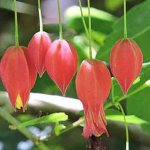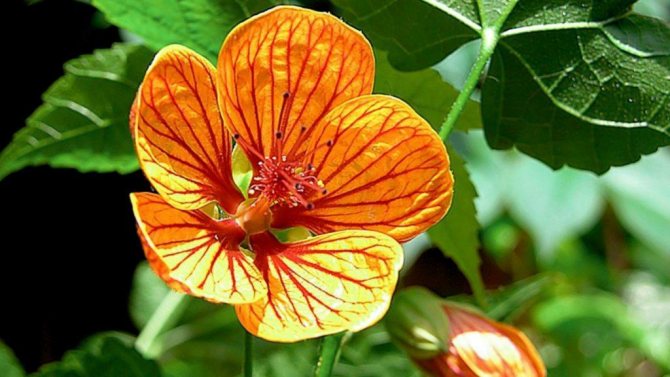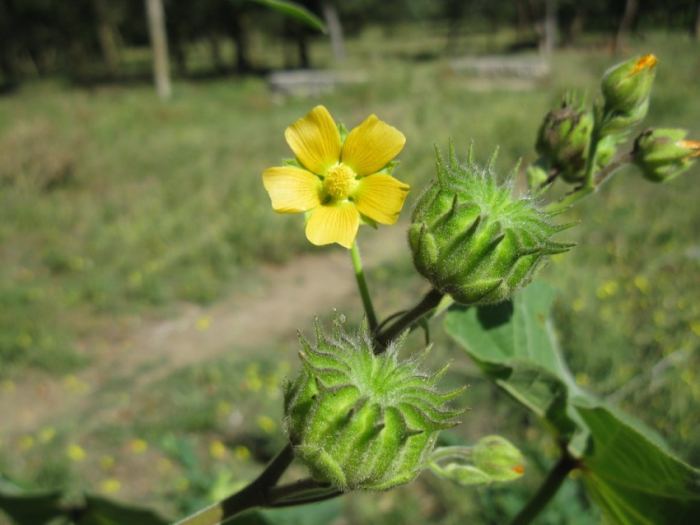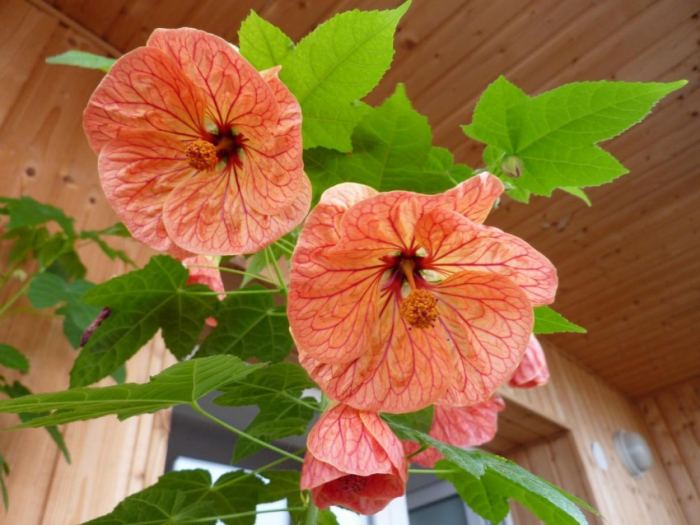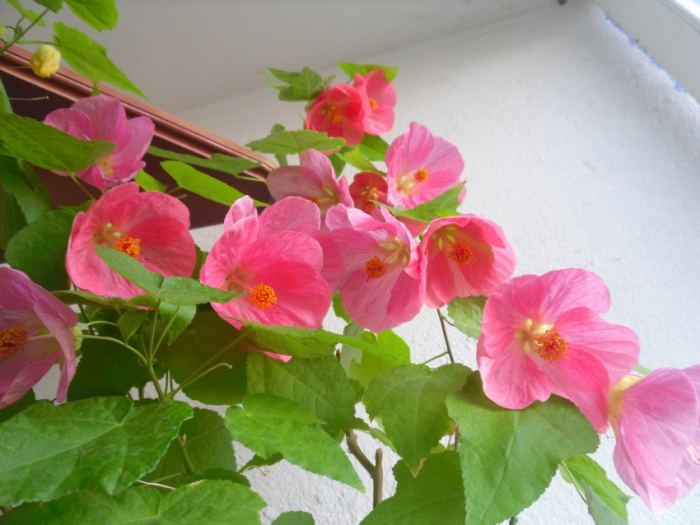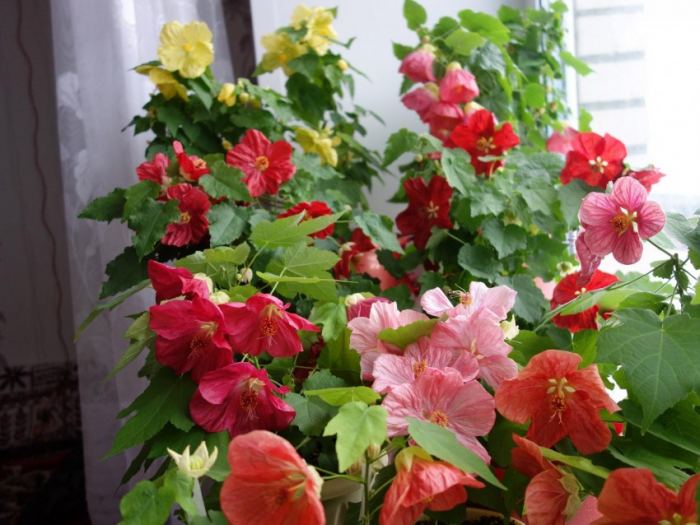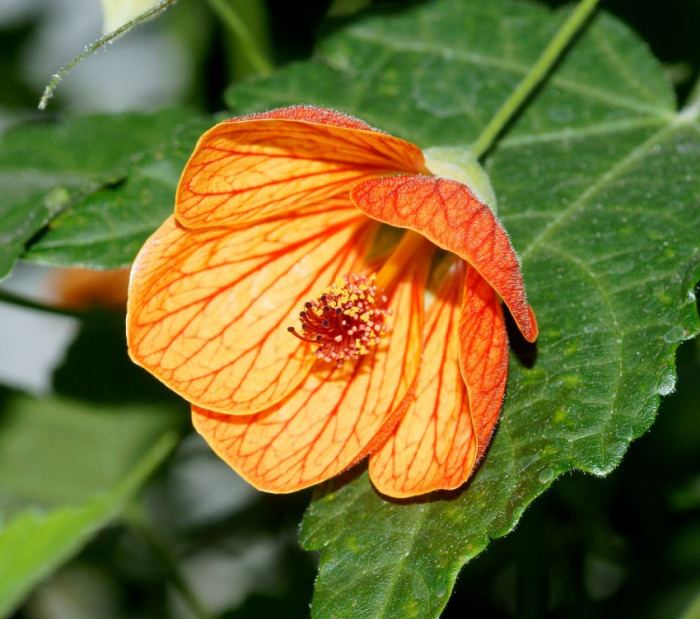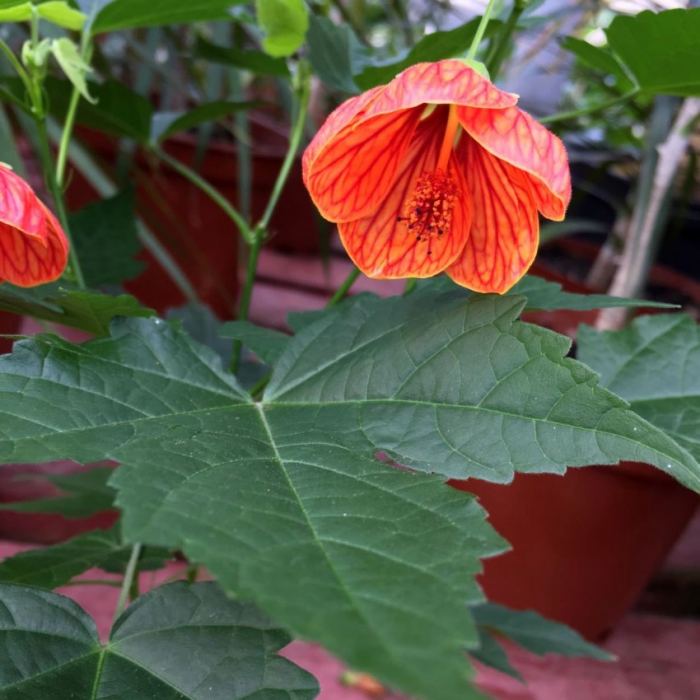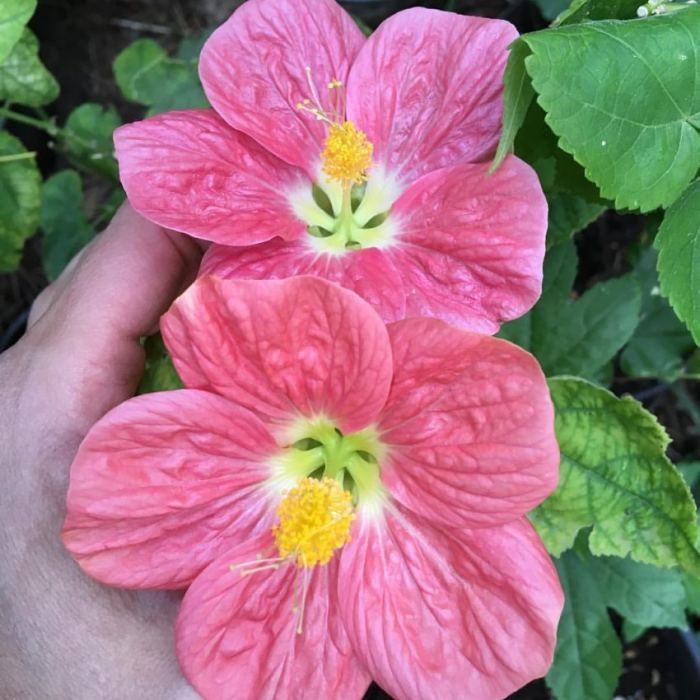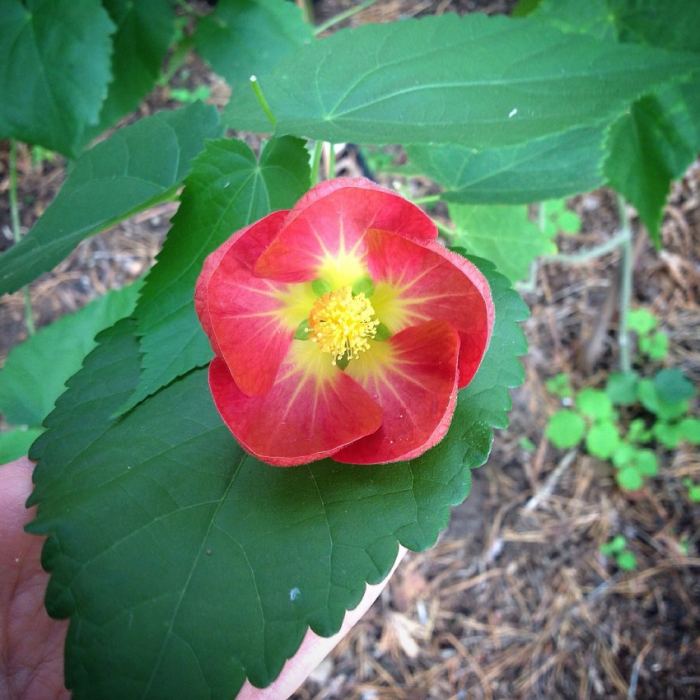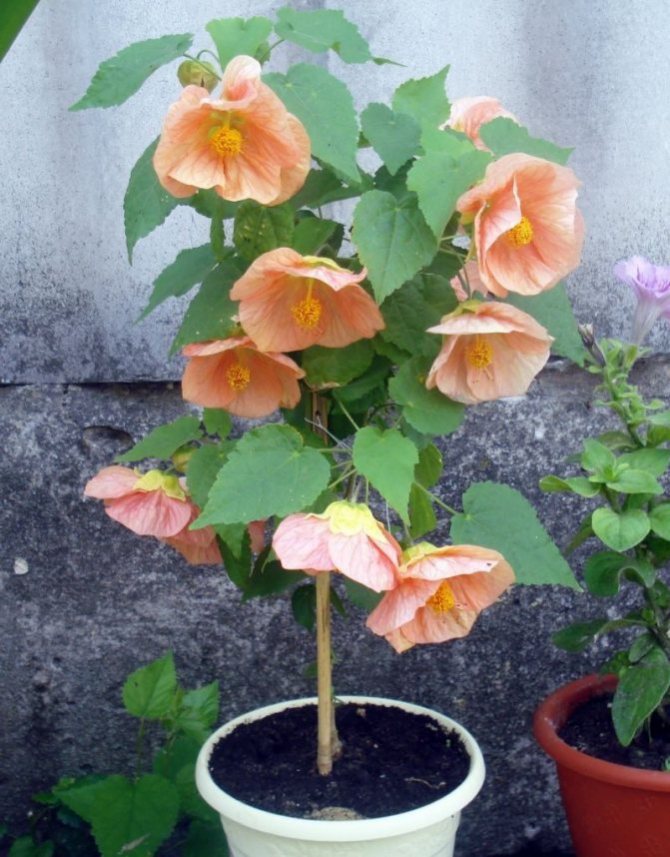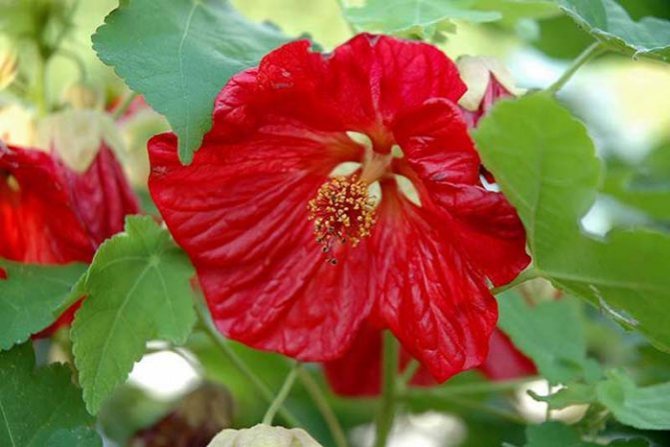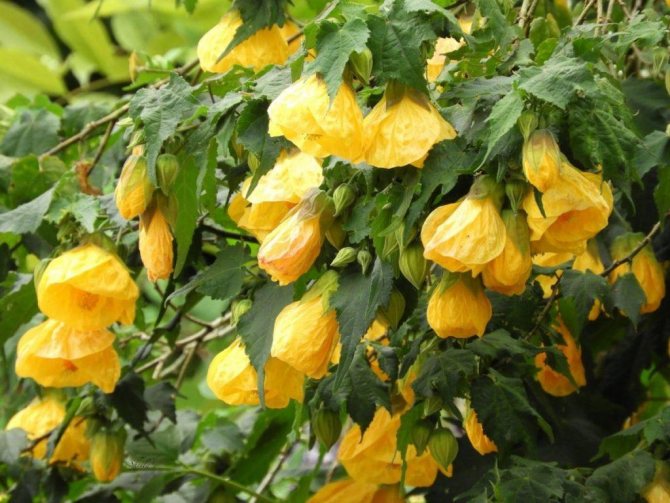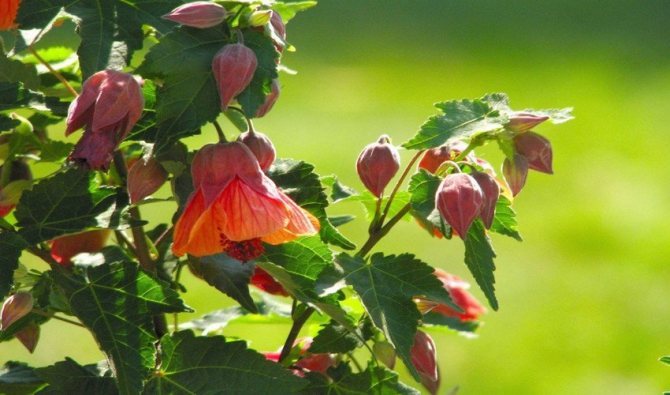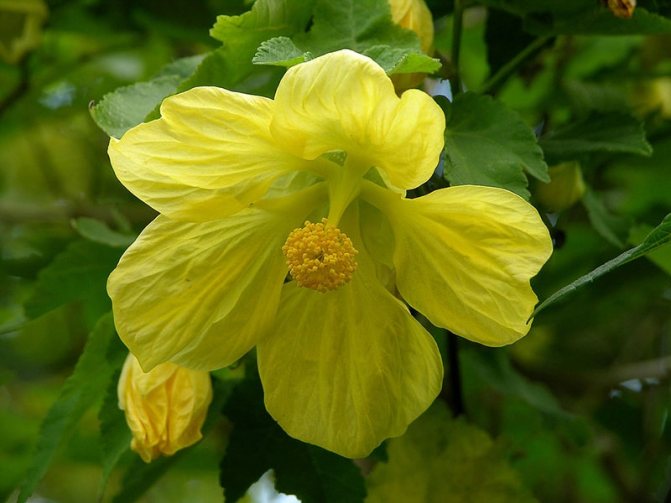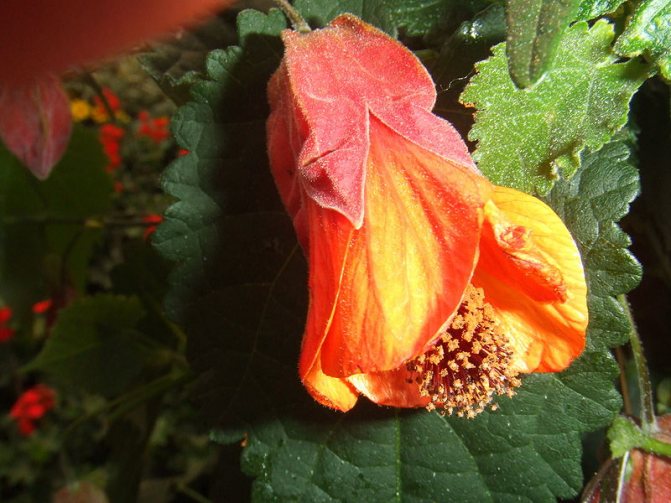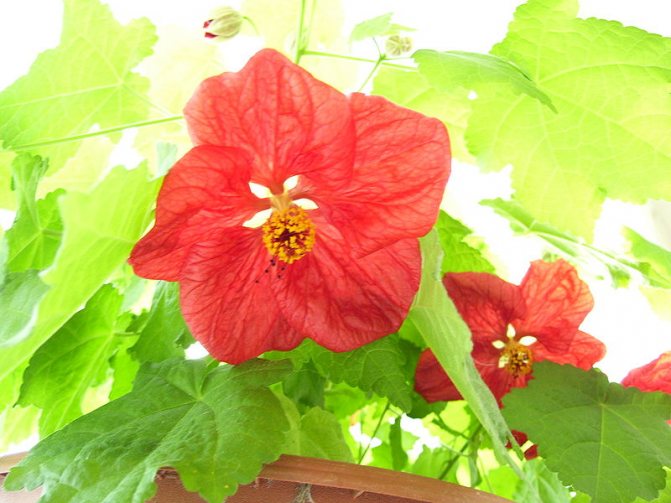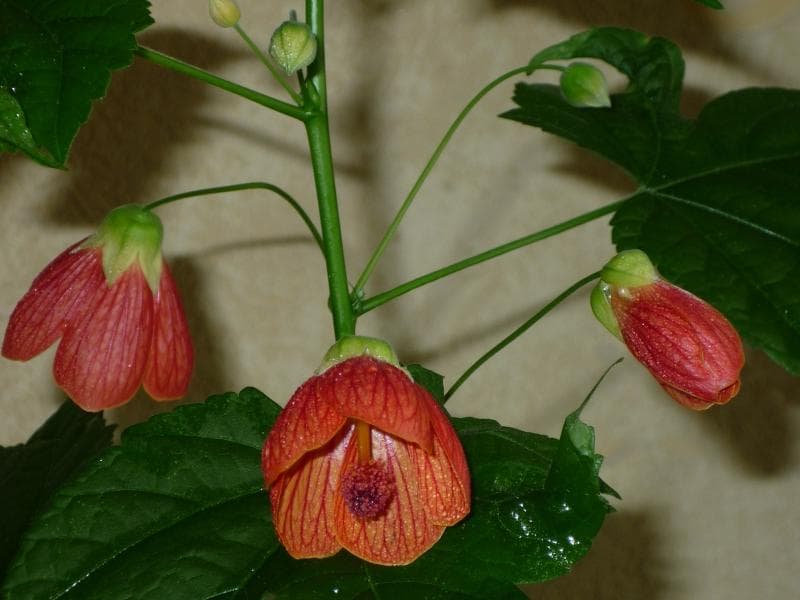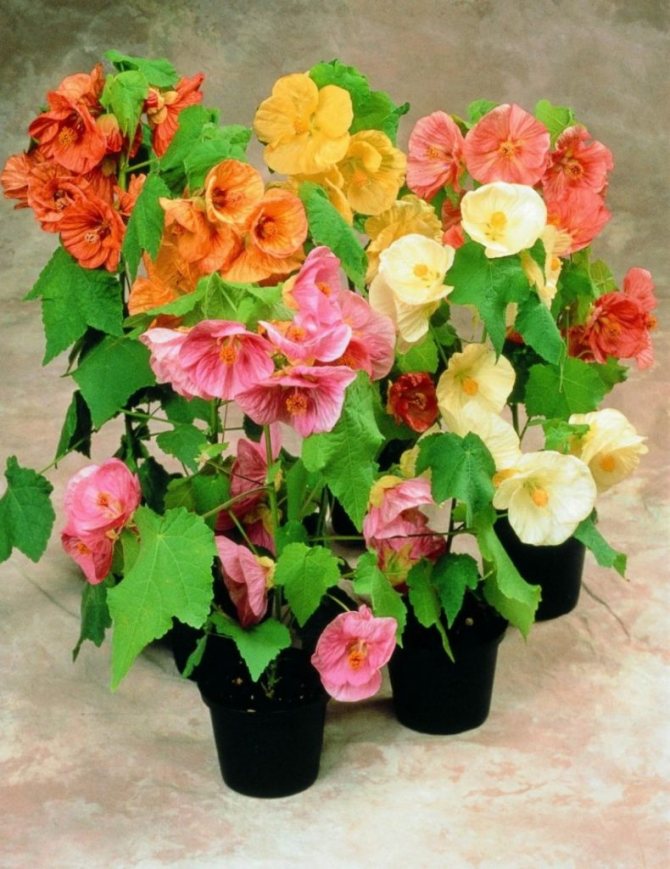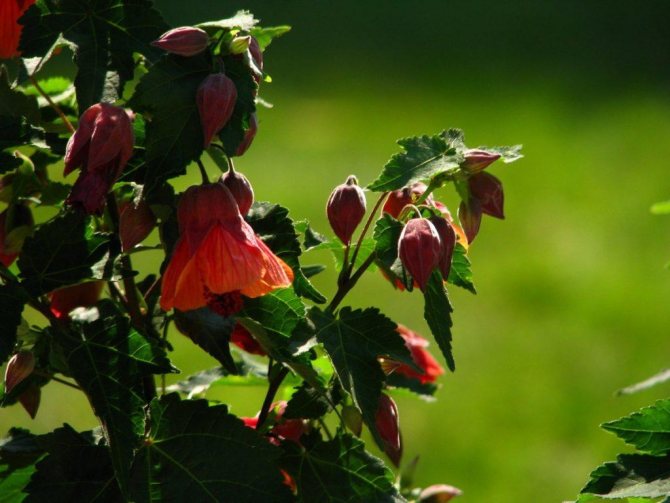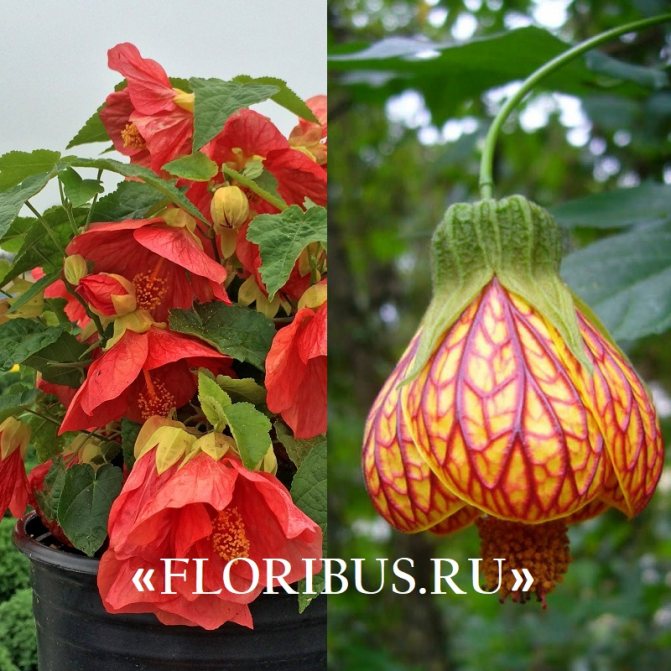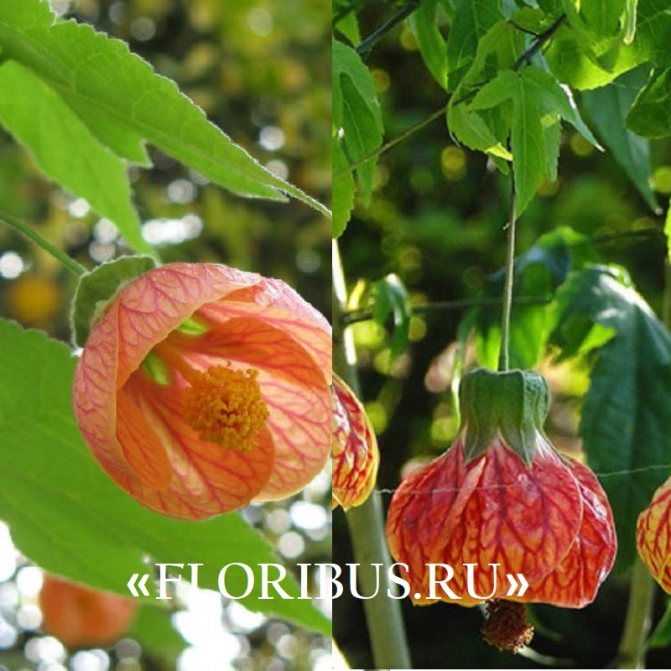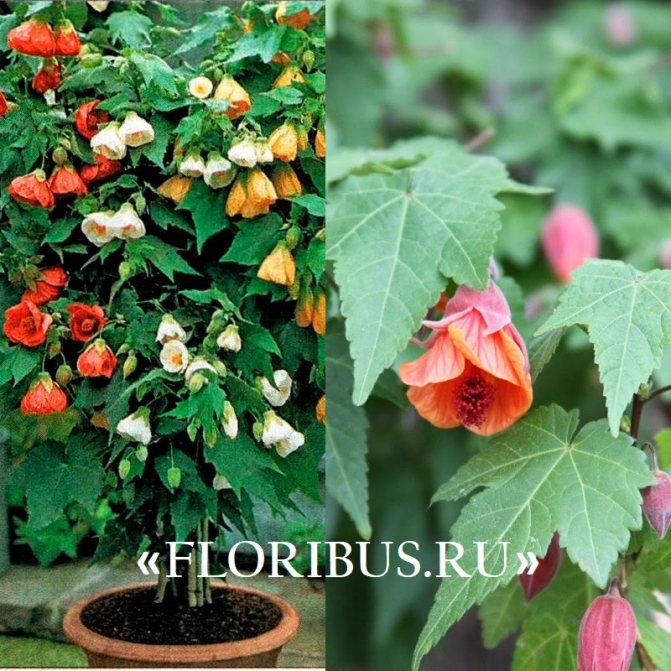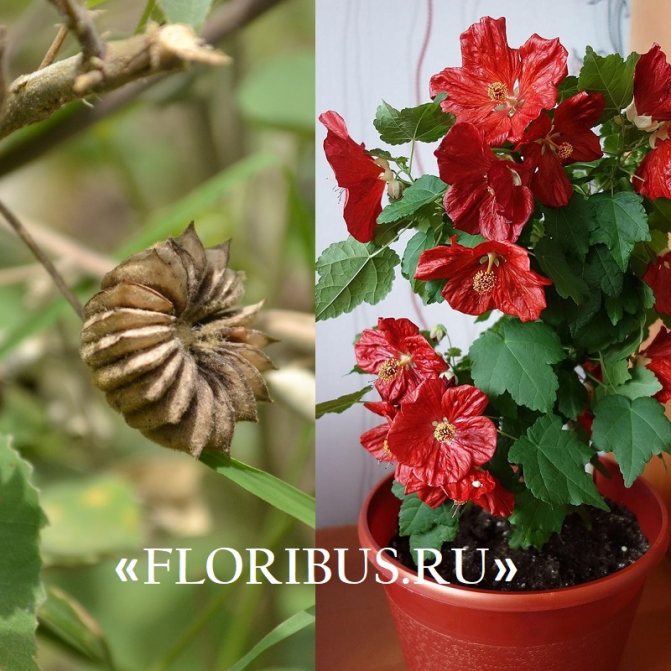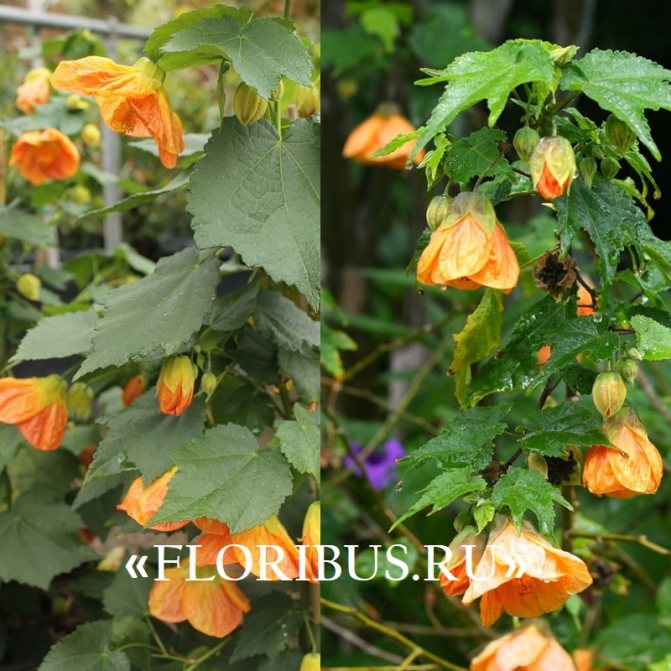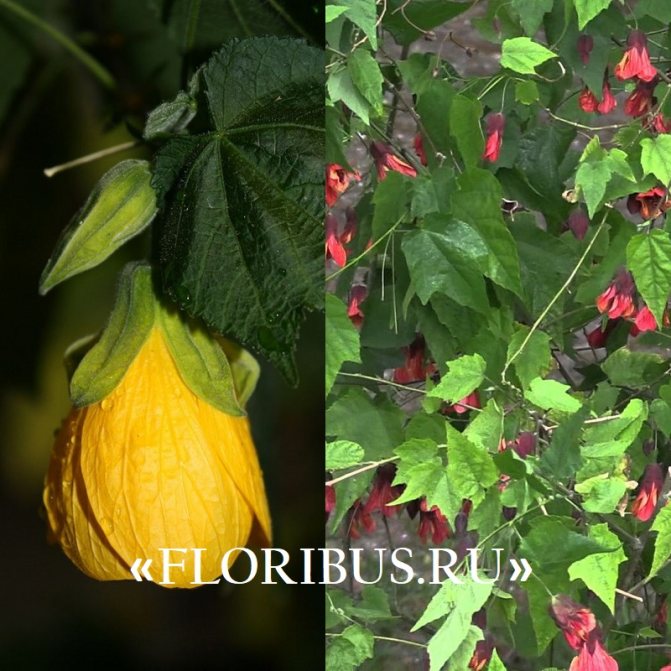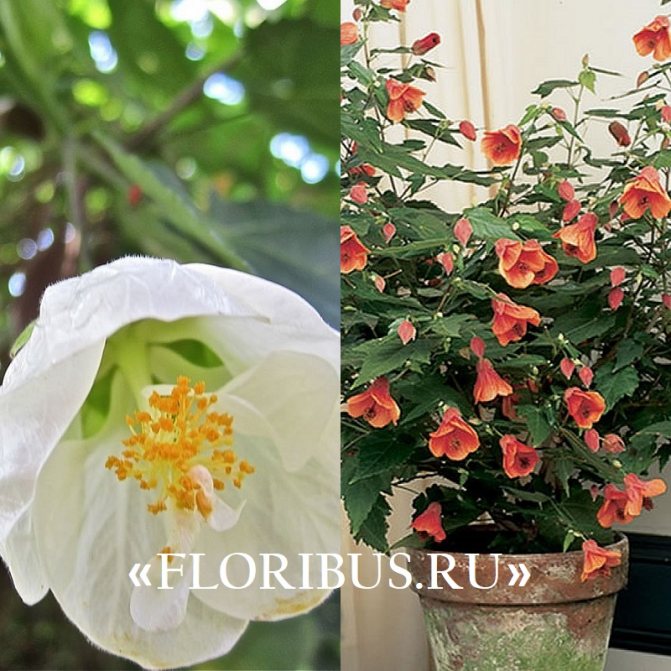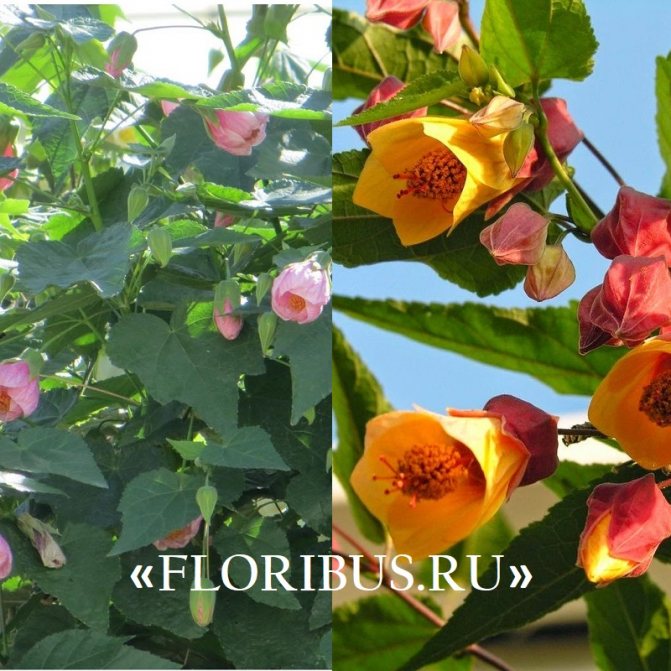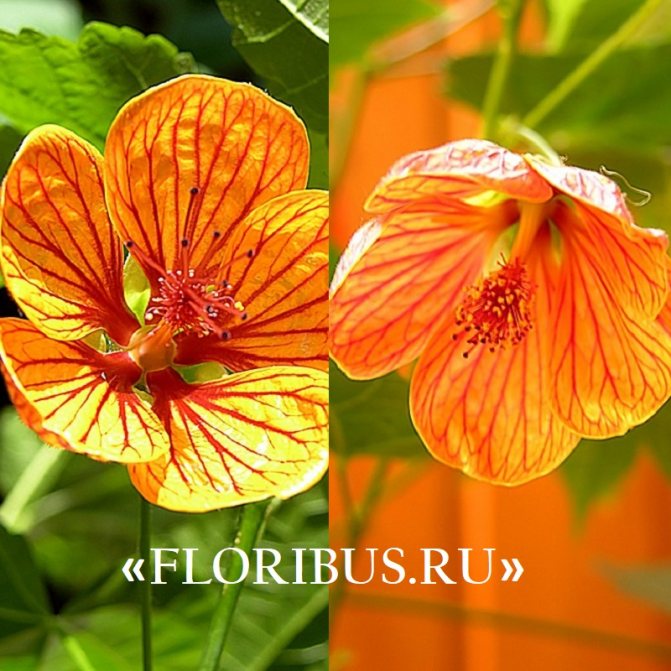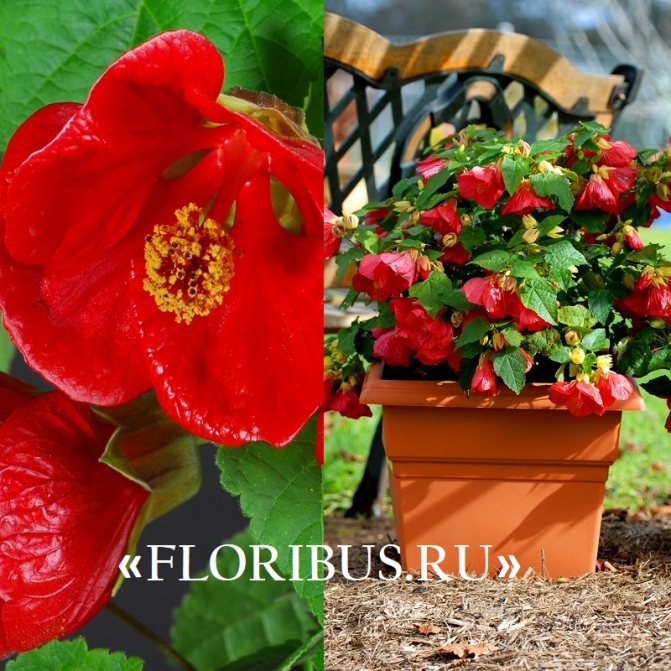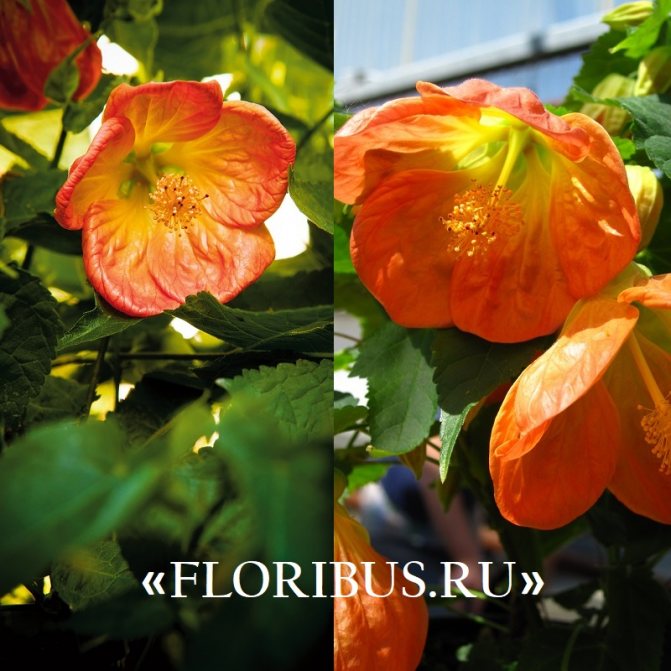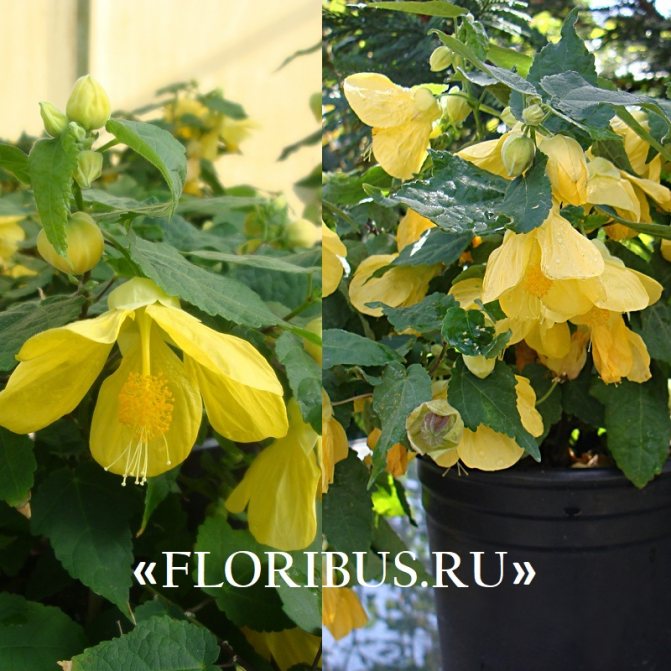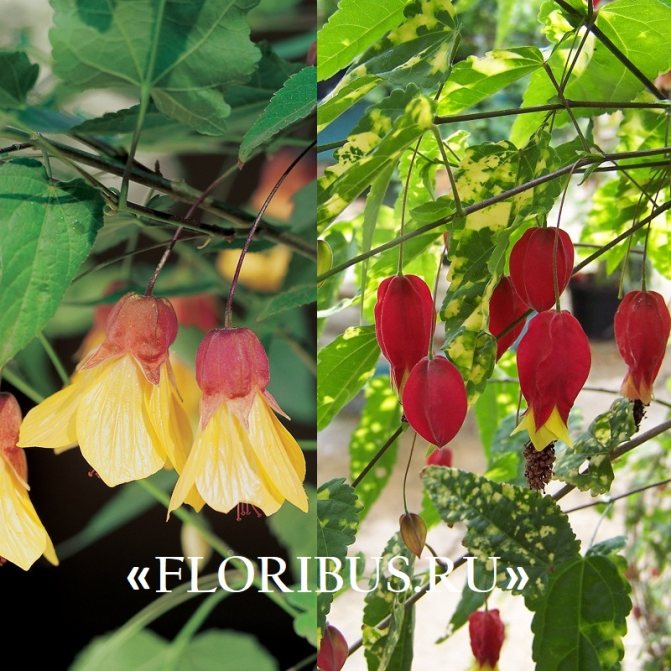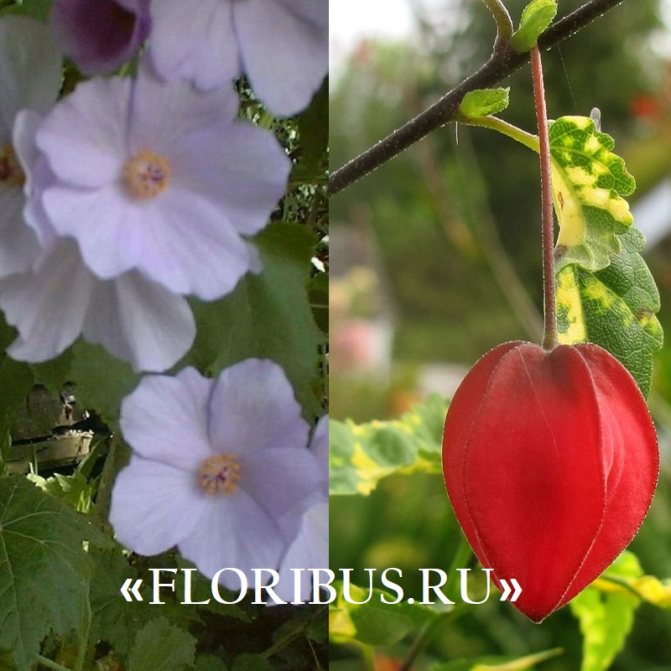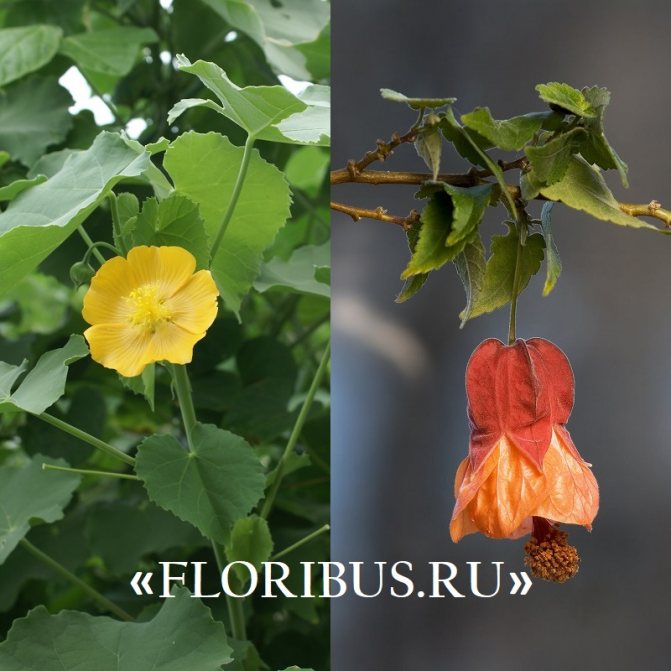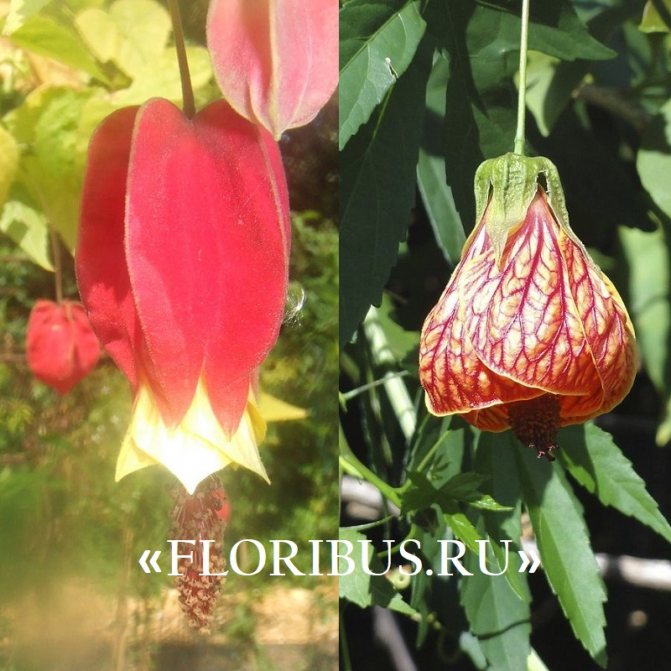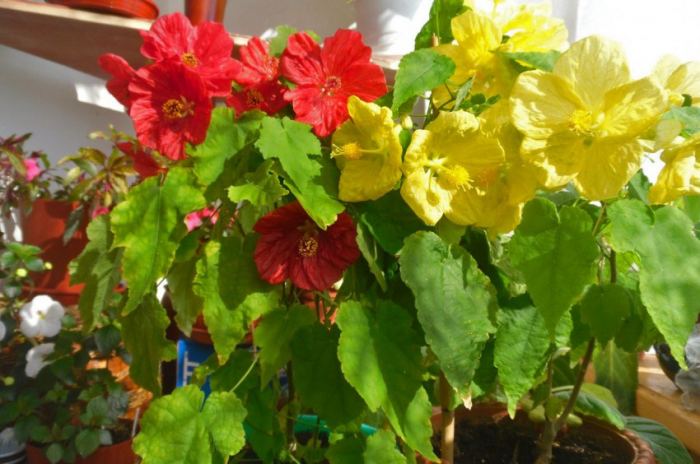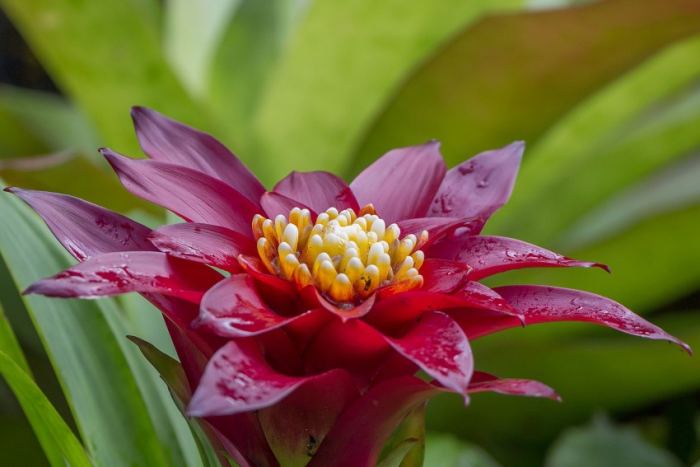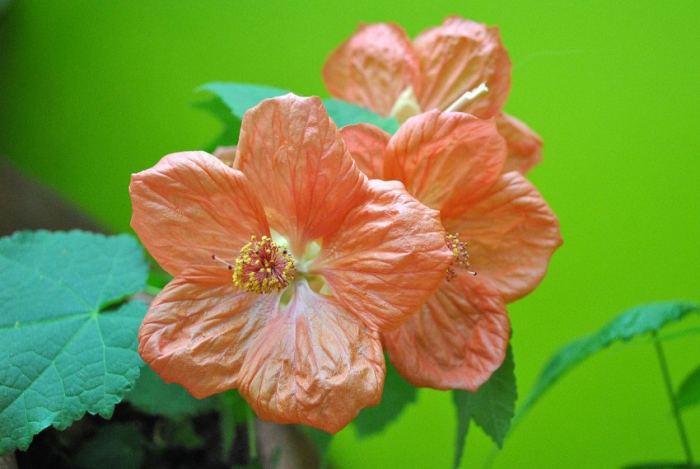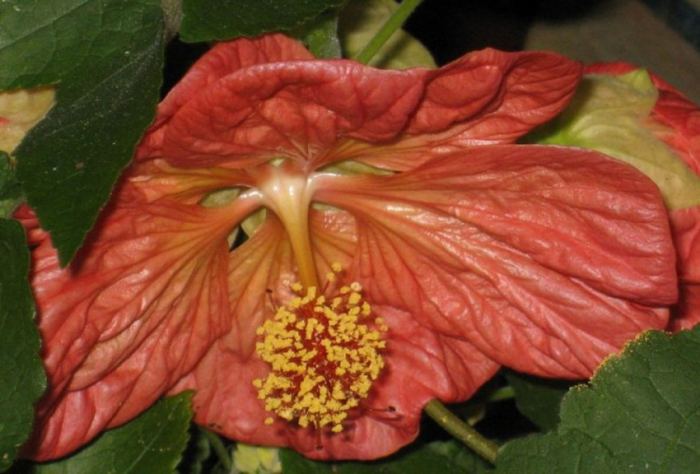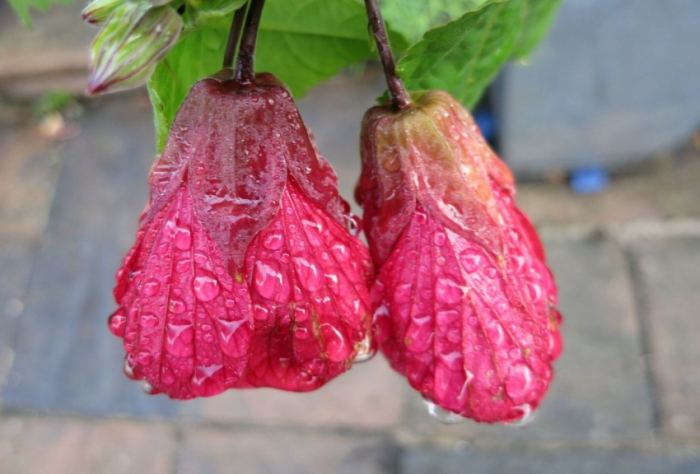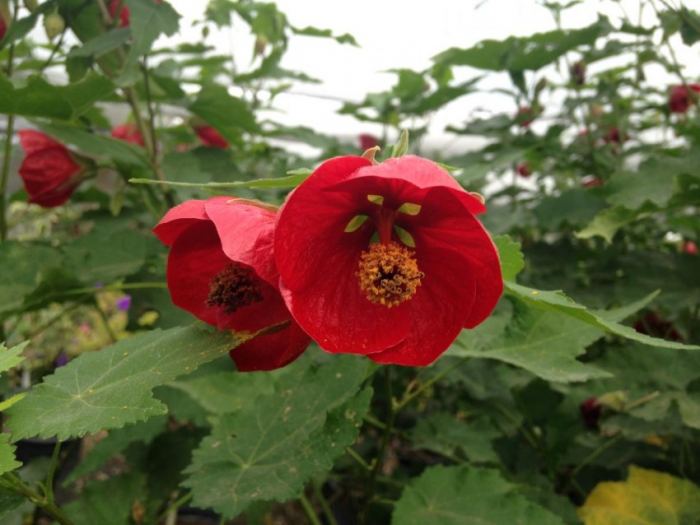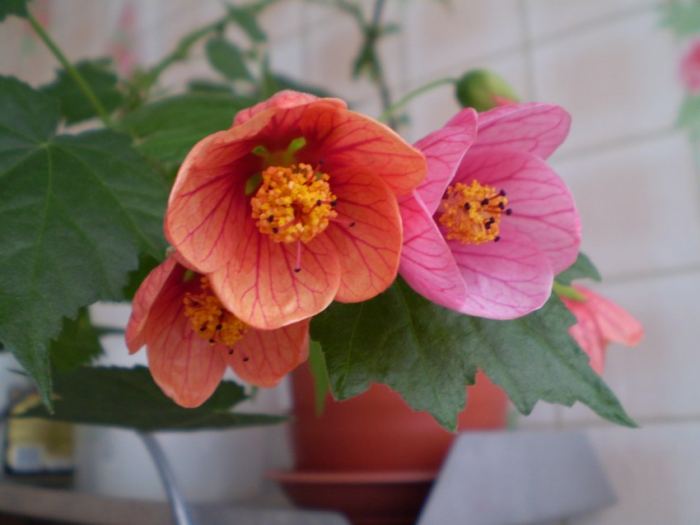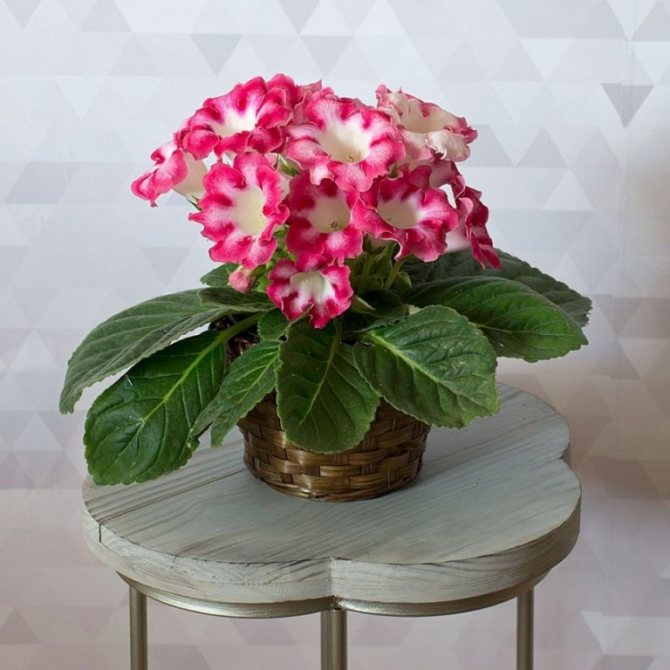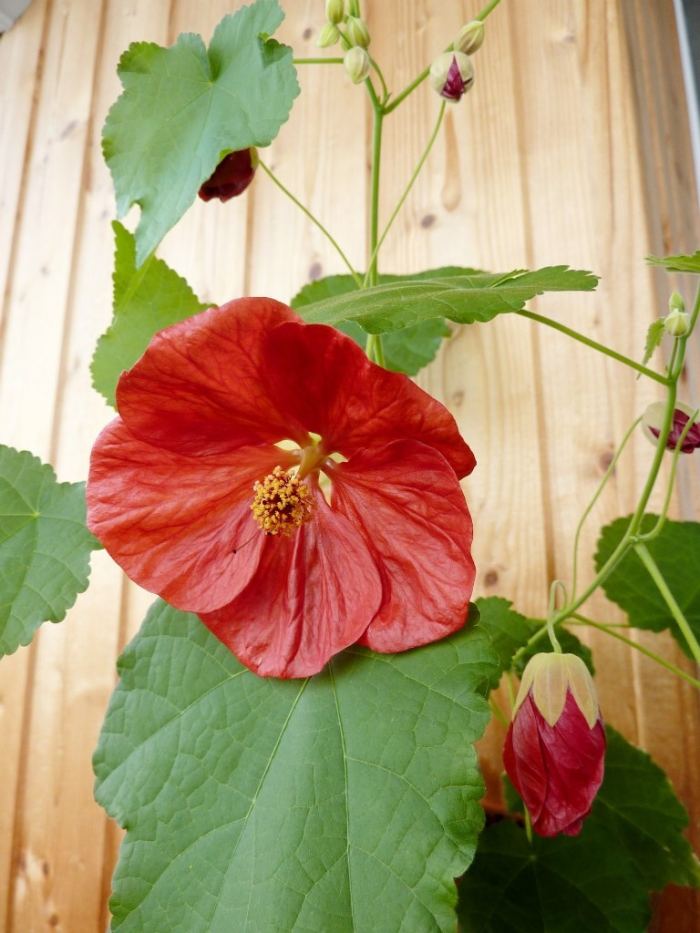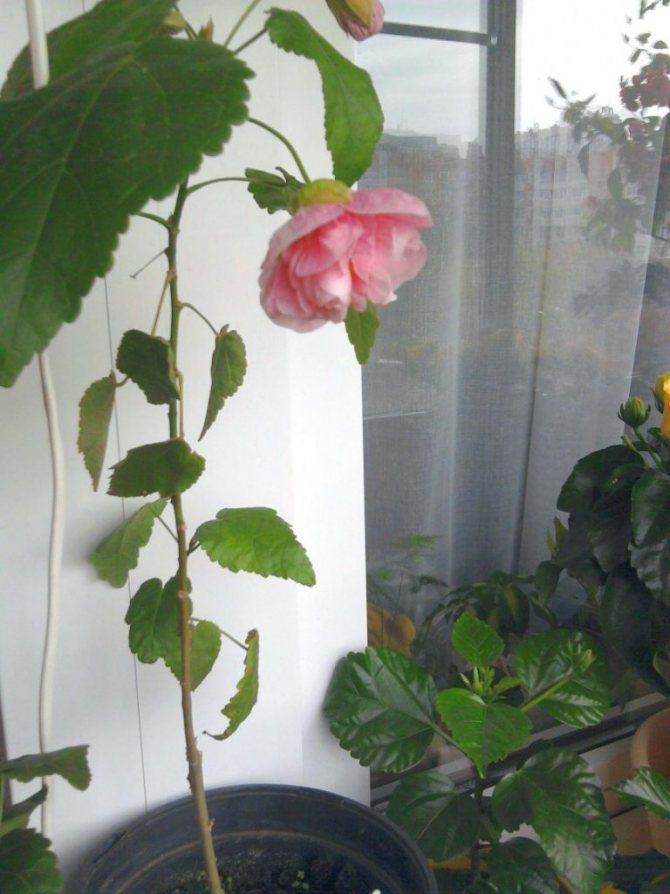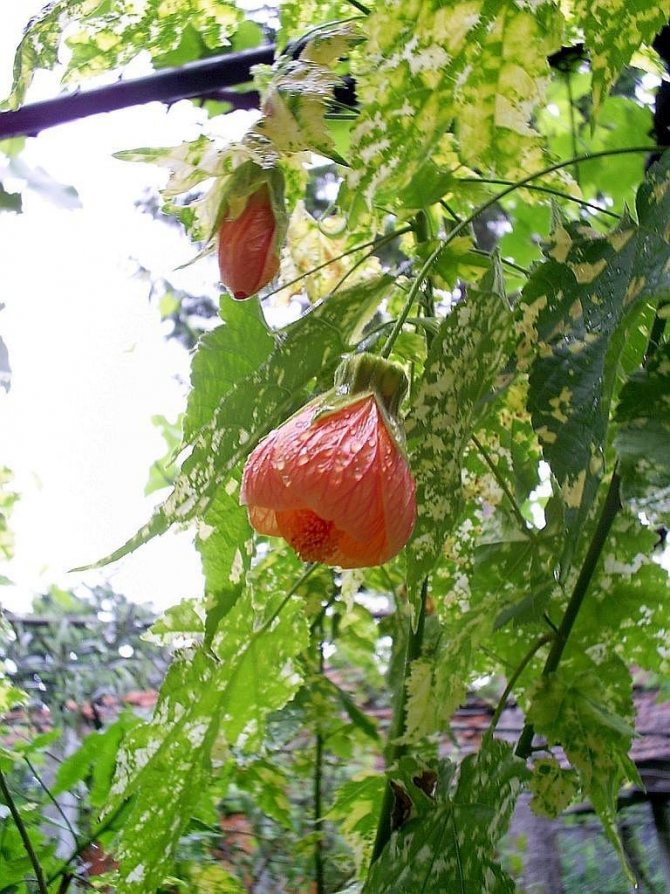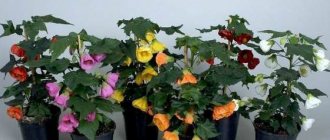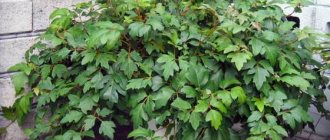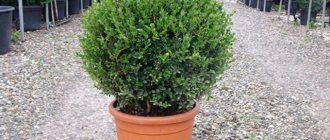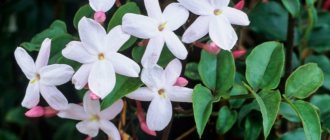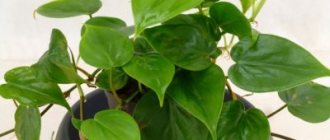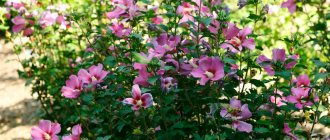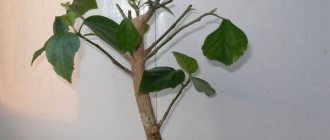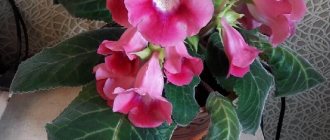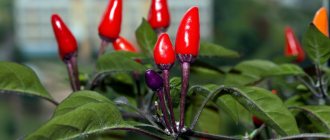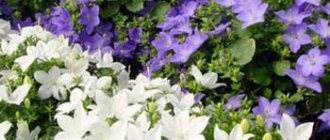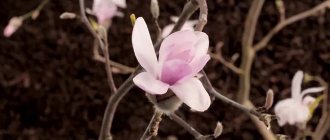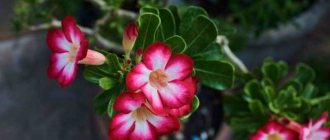Abutilon is a small tree or shrub with leaves that resemble maple leaves, hence the name "indoor maple". How to take care of abutilone at home? Photos, types and names, description of varieties. Despite the unpretentiousness, some of the nuances when growing them should be taken into account.
This flower has some advantages: abundant flowering, grows quickly, easy to grow from seeds, good for beginner growers. Having created favorable home care for him and the indoor maple abutilone in a pot will bloom in a few months.
The genus abutilon (Abutilon Mill) is about 200 species of shrubs of the Malvaceae family (Malvaceae) ... The Latin name is "abutilon". Inhabitant of the tropics and subtropics of South America, Australia, China, India. In our northern latitudes, it is a pot plant.
The plant has received massive distribution and recognition in Europe since 1837. Due to its spectacular appearance, it invariably attracts the attention of everyone who sees it for the first time.
In indoor floriculture, the following types of abutilon are common: Selova, Amazonian, hybrid ... The most common abutilone is hybrid, combining three groups: A. Darwin (A. darvinii), A. painted (A. pictum = A.striatum), A. megapotamskiy (A. megapotamicum). Modern hybrids are more and more striking in their magnificence!
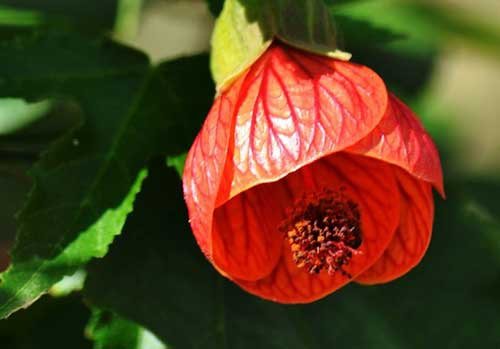
In the photo: indoor maple abutilon is available and easy to care for ... Abutilon x hybridus. Hybrids of all shades of orange, yellow, red, pink, white. Sometimes with contrasting dark or light veins. The flowering of hybrid forms is longer.
Names: "shade-giving", "rope-way", "indoor maple", "Indian mallow", "Chinese lanterns". The phrase "Indian mallow" most accurately defines the nature of the plant, due to the close relationship of abutilon with mallow and hibiscus.
Due to the lowered bright flowers that resemble glowing lanterns, the abutilon plant is called Chinese lanterns. "Ropeman" was nicknamed because in India coarse fibrous fiber is used for the manufacture of wickerwork, burlap, ropes.
Abutilones begin to bloom at a young age, whose flowers barely rise above the pot. It is surprising that the flowering is constant. This is such a cute tree with lovely flowers - the maple plant "Abutilon" combines ease of care, compactness, high decorativeness.
Choosing “your” maple flower, you have to take into account some, sometimes barely noticeable, inherent only to a certain variety, features. Consider the most suitable types and varieties of abutilon for home maintenance.
- 'Bella' is a recently bred variety, it is distinguished by its small growth up to 40 cm, the presence of voluminous beautiful bright flowers of pink, golden color, a diameter of about 8 cm. It blooms throughout the year. It does not need pruning and pinching;
- ‘Juliet’ is an unpretentious species of half a meter in height, the cultivation of which does not require abundant lighting, frequent watering. Six months after sowing the seeds, it gives bright large flowers;
- ‘Sello’ is a kind of domestic maple - abutilon, informally called “grandmother's”. Abutilon sellovianum. Tall, up to 2.5 m. Flowers - drooping bells, 5-7 cm in diameter, hanging from branches on long stalks.Bright orange, lilac, red with a fine mesh of contrasting maroon veins ... The variety can be variegated - with variegated leaves.
- ‘Bellevue’ is a hybrid mixture, flowers of abutilone with coloring to match all the colors of the rainbow. It is a lush bush, decorated with bells, up to two meters high with constant pruning. In the open air garden they appear in all their glory, growing in a couple of months. Abutilon Flowering Maple Bellvue - (English "beautiful view of a flowering maple"). Bellevue (French Bellevue, Bellvue "beautiful view").
- ‘Bella mix’ - a hybrid with large flowers (diameter 8 cm) of gentle tones: yellow, apricot, pink;
- 'Tiger's Eye' is a beautiful large shrub with orange-colored flowers and red veins, reminiscent of a lantern.
- ‘Aurum’ (‘Aurum’, 2013) - one of the best large-colored jewelry in many collections; slow-growing domestic hybrid, reaching a height of no more than 50 cm. This spectacular "golden" indoor maple is unpretentious in maintenance and is perfect for growing at home.
- 'Harlekin' is a very interesting variety. It got its name because of its non-trivial appearance. An adult plant with its bright, wave-like inflorescences and a compactly elongated upward shape of a bush subtly resembles a Harlequin.
- There are known hybrids that have flowers of different colors or two colors on one plant, for example: ‘Golden Terracotta’, ‘Sonnentanz’ or ‘Versicolor’.
- If the care of indoor maple is carried out in a timely manner, then nothing threatens it. Compliance with the recommendations for care and maintenance will help grow a beautiful and healthy bush.
Characteristics of abutilone
There are several other names for abutilone. Indoor maple is called for the similarity of their leaves in shape, Chinese lantern - because of the bright flowers tilted down. In India, for a long time, a rope (rope) was made from it. Another name appeared for him - the cable car.
In China, it is grown as an agricultural crop. In Russia, one type of abutilone is growing, containing suitable fiber - the Theophrastus rope.
Translated from the Latin language, the word "abutilon" means "giving a shadow." So it was named for the wide dense crown of an adult plant.
Abutilon belongs to the Malvaceae genus. There are up to 200 species. It grows naturally in India, China, Africa, Australia, South and North America. It can be both herbs and shrubs, small trees.
At home, it is an ornamental pot plant. He is loved for the original shape of the leaves, delicate bell-shaped flowers, rapid growth. It is better to give preference to hybrid varieties. Their peculiarity is the compactness of the crown and large flowers.
The most frequent guests in our house are varieties of abutilone:
- hybrid;
- Amazonian;
- striped;
- megapotamian;
- A. Darwin.
Types and varieties of indoor maple differ from each other in shape, size of the plant itself, size and color of the flower. The color scheme is varied. On red, yellow, purple, burgundy, pink, cherry, white petals, a veined contrasting pattern is sometimes visible. There are double flowers.
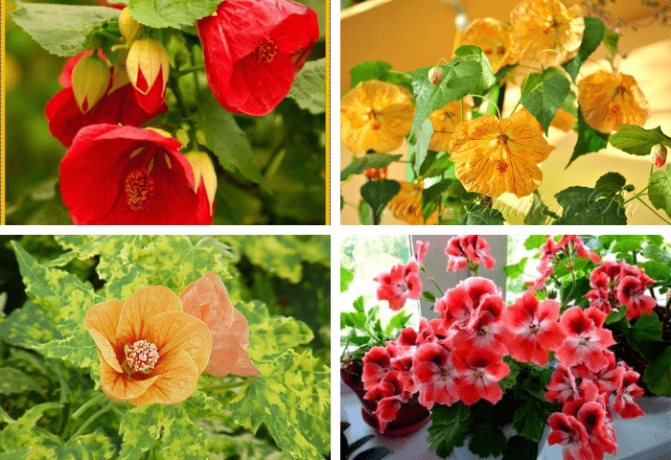

Various varieties of abutilon
The variety of their species is manifested not only in the color of the flowers, but also in the heterogeneity of the leaves. There are evenly colored, variegated and even striped leaves.
Interesting to know. There are very beautiful variegated varieties of abutilon - marble with a border. However, there is a difficulty in growing them - the requirement for lighting.
Abutilon is considered a plant with magical properties:
- It has a beneficial effect on the energy of the home. He relieves residents of bad thoughts, improves their mood. Therefore, it is recommended to grow it for people prone to depression.
- The presence of a flower can add creative energy to a person, bring his ideas to life.
- He instills self-confidence in indecisive people.
- Abutilone is useful to breed in offices. Its solar aura helps to solve problems related to human communication. They show more attention and kindness to each other.
It is not recommended to keep abutilone in the bedroom or children's room. It emits energizing energy. A person's sleep in such a room will be restless and disturbing. The child may often be naughty and over-expressive.
In addition, this plant also has medicinal properties. It is a kind of air filter. In the room where it grows, there is always fresh air and a healthy atmosphere.
Abutilon Theophrastus is endowed with wound healing properties. This knowledge is used in the treatment of furunculosis.
Indoor abutilon - flower description
Homemade maple is brought up because of the unpretentiousness and attractiveness of the plant. Care and cultivation of a plant are not distinguished by complex manipulations, so even a novice florist can afford such a "pet". You can recognize the abutilon plant by the following external characteristics:
- The bud resembles a bell with rounded petals at the edges. Flowering continues from mid-vein to mid-autumn. Abutilon flower has different colors: red, white, yellow, scarlet, crimson, lilac.
- The leaf resembles a maple leaf. Carved edges that are divided into 3-6 blades. The leaves are light green in color; white specks may be present on the edges.
- A tree or bush can reach a height of more than 2 m. Depending on the variety, the parameter of the stems can be different.
Indoor abutilon grows rapidly, the crown can be given any shape by cutting branches. Therefore, the flower is used not only for decorating the room, but also for terraces, open flower beds.
Important! If you put an indoor flower on a well-lit windowsill, then flowering will continue all year round.
Additionally, you need to regulate the correct seasonal watering. The leaves are large, so the plant evaporates a lot of moisture from the environment. Thanks to this function, a favorable microclimate is established in the room.
Legends, signs and beliefs about abutilone
There is a very beautiful legend about the indoor maple, which tells about the love of a beautiful girl, the daughter of a leader, for a poor guy. Knowing that the girl's parents are opposed to their marriage, the lovers decided to run away.
When her father found out about this, he ordered to kill the young man and throw him off the cliff. He told his daughter that the guy stopped loving her and left. However, she did not believe it, all the time she waited for his return and cried. In places moistened with her tears, beautiful flowers (abutilones) with many shoots appeared.
Thanks to this legend, abutilone is considered the flower of brides and wives. At wedding ceremonies, it is used to decorate halls. According to the sign, this will help loved ones always stay together.
Drinking a decoction from its seeds will help a girl getting married to get pregnant faster and give birth to a healthy, beautiful baby.
An ancient belief says that being in the same room with a cable car helps to recover seriously ill patients.
Reproduction: step by step instructions
Propagated by seeds, step by step instructions:
- The soil is sieved for looseness and better moisture retention. Low acidity soil is disinfected with a manganese solution.
- The seed is soaked in lukewarm water for 12 hours.
- The seeds are planted in pots to a depth of 5 mm. The pot is covered with polyethylene, placed in a warm place under the sun. From germinated seeds, seedlings appear in about three weeks.
- During the formation of greenery, the sprouts are transplanted into separate containers with a diameter of 7 cm.
Vegetative propagation is best used in August:
- A 12 cm root with a flexible stem is taken.The bottom buds and greens are removed.
- The shoots are planted in small containers, covered with banks (favorable greenhouse conditions are created). After about a month, the shoots will sprout creeping roots. We must not forget to water, irrigate, air.
- The planting of mature seedlings is carried out in pots with a diameter of no more than 7 cm.
How to care for abutilone
It is known that abutilone is an air humidifier. Spraying is optional for him. But if the room has a dry atmosphere, then flowering stops, leaves and flowers fall. This happens most often during the heating season. At this time, pallets with water are placed next to it.
It is not very dangerous for home maple to be in direct sunlight, but it is still better to create conditions for it with diffused lighting. If the plant is installed on a southern windowsill, then it is advisable to place it in another pots with a larger diameter. You can not spray it in case of exposure to the sun. This leads to leaf burns.
To preserve clear patterns on abutilones with variegated or light colored leaves, they are shaded.
Good to know. Insufficient lighting leads to pallor and dullness of the leaves, stem elongation. With an excess of light, yellowing and twisting of the leaves occurs. The tips of the shoots dry up.
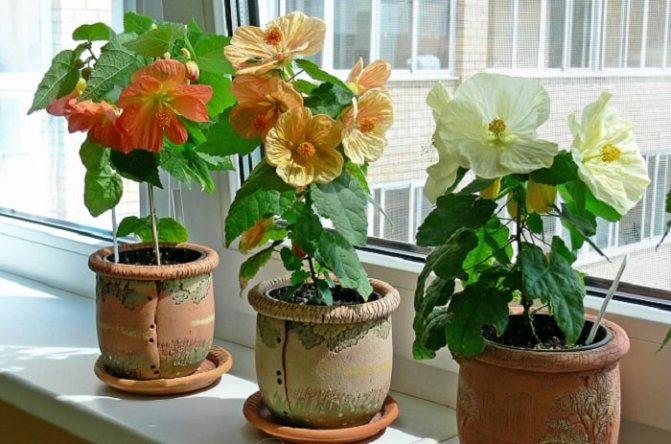

Lighting abutilone
In summer, abutilon feels good in the garden, on the open terrace. The main thing is to choose a place for it without drafts and not very sunny. Despite its southern origin, a constant presence in a warm room is not always beneficial.
A comfortable temperature regime for him is 16-25 ° C in summer, 12-15 ° C in winter. A drop in air temperature to 5-10 ° C leads to leaf shedding. If the room is too hot, within 30 ° C, then the buds are not tied. In such cases, spraying is needed (the plant should not be in the sun).
How to feed and water indoor maple
Indoor maple blooms from April to November. At this time, he needs top dressing and regular watering.
Do not allow the soil to dry out. The likely result is shedding of buds and yellowing of the leaves of the plant. If you noticed that the top layer of the soil has dried up, pour it with settled water at room temperature. It is recommended to reduce watering in winter. In the spring, during the active growing season, they begin to feed it with mineral or organic fertilizers. Frequency - once every 14 days.
At the beginning of flowering, feeding is carried out with nutrient mixtures for flowering plants. Their regularity directly affects the abundance of flowers and the quality of flowering. Useful advice from experienced florists. Top dressing should be carried out with formulations with a concentration lower than indicated in the instructions.
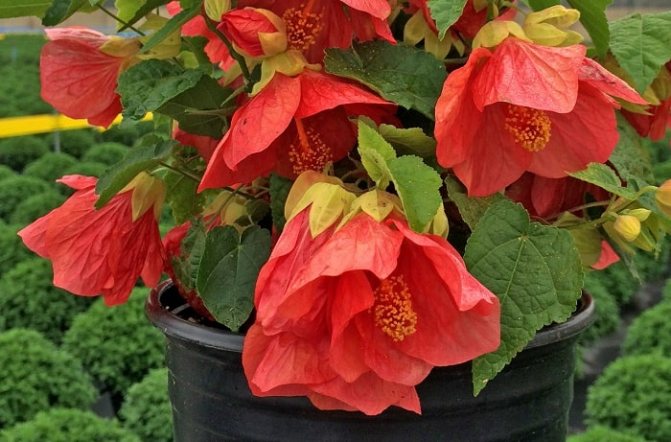

The flowering of abutilon depends on the correct application of fertilizers
Fertilizers containing phosphorus and potassium contribute to bud formation. They are preferred during mass flowering. After pruning, nitrogen preparations are added to the plant so that new foliage grows faster.
Yellowing of the leaves is observed with a lack of mineral fertilizers. In winter, abutilone is not fertilized. His growth activity decreases.
Caring for abutilon in winter
Consider two options for winter maintenance of indoor maple:
- Placing it in a house maintaining a temperature of 18-22 ° C. It is necessary to equip additional lighting, produce moderate watering after the soil dries up to half the pot. Top dressing should be carried out only in cases of manifest nutritional deficiencies. Make sure that the root system does not overcool. You can install the pot on a piece of styrofoam.
- For cold wintering, abutilone is placed on a loggia or veranda. The main condition is an ambient temperature of at least 10 ° C. Watering is scarce. Top dressing is not applied. Not all growers practice cold wintering.
Varieties
A wide variety of varieties can be purchased on sale, so it is worth taking a look around and choosing the most suitable variety.
Popular Bella series includes colorful forms with large flowers, the diameter of which reaches 7 cm.
- "Red" with burgundy flowers,
- "Deep Coral" with coral flowers,
- Apricot Shades with apricot flowers,
- Salomon Shades with salmon-colored flowers.
It should be noted that these are dwarf forms, the height is about 45 cm.
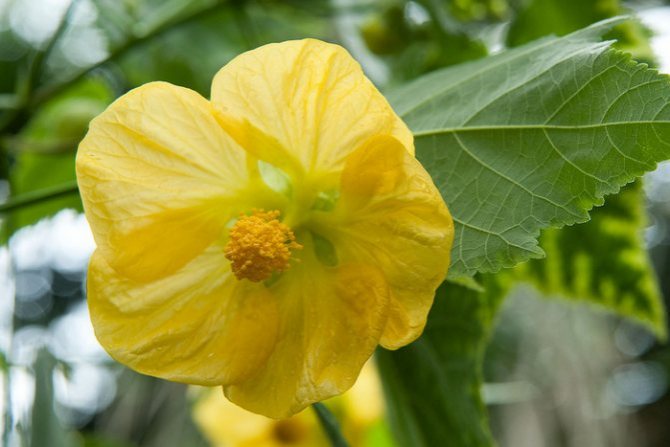

Yellow color will delight varieties: "Canary Bird", "Golden Fleece", and spotted leaves "Cannington Carol", "Cannington Sally". Ashford Red blooms red. A particularly beautiful variety is "Savitzii" with decorative white-framed leaves.
Currently popular hybrid abutilone Juliet color mix, a mixture of varieties of different colors and Bellevue variety - a mixture of colors, shrub 90 cm high, blooms summer-autumn. Maple green leaves. The flowers are large, of different colors.
Varieties with variegated leaves are the result of infection with abutilone viruses... The presence of the virus in the cells does not significantly affect the growth of the plant, it may slow down the growth a little. Indoor maple with spotted leaves looks original.
Transplanting requirements and soil composition
The best time for transplanting work is spring. A ready-made substrate for flowering plants or one prepared by yourself is suitable. Recommended composition:
- sod land - 3 parts;
- leaf land - 2 parts;
- sand - 0.5 parts;
- humus - 1 part.
The substrate should be neutral or slightly acidic and contain enough humus. A drainage layer is required at the bottom of the pot.
Important requirements for transplanting are the need to shorten the root system, trim the aboveground system, and add fresh fertile soil. Otherwise, the plant will reach a fairly large size, not suitable for placement on a windowsill.
Helpful advice. When transplanting a room maple, a pot is selected not much larger than the previous one. In a cramped pot, it will bloom more abundantly.
Breeding methods for home maple
There are several ways to reproduce abutilone.
Propagation by cuttings
The most common breeding method is cuttings. The procedure can be performed all year round. In the spring, semi-lignified shoots are taken for cutting, and in the summer, the apical ones.
For rooting, they are placed in a mixture of sand and peat, water or in an ordinary substrate. Create a mini-greenhouse conditions for the plant. Cover the cuttings with a plastic wrap cap. Open periodically for ventilation.
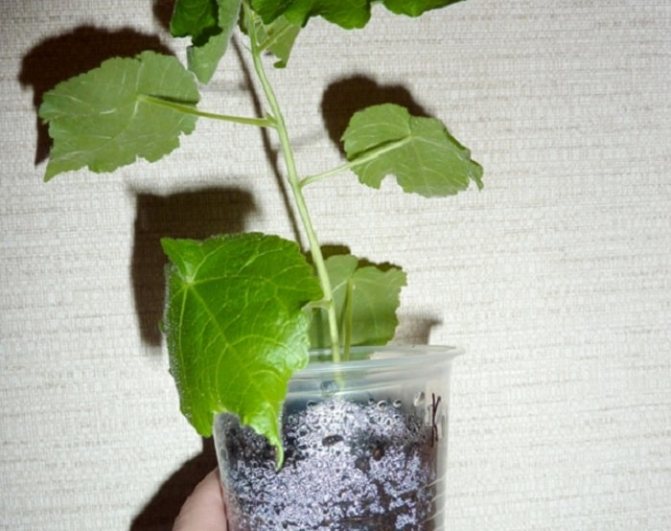

Rooting the cutting
Benefits of the vegetative method:
- The grown plant retains its maternal properties: variegated foliage, color of flowers.
- The growing period is shortened, in contrast to the seed method. The first flowers appear much earlier.
Seed breeding method
This method is more often used by breeders when developing new varieties. Although there are no particular difficulties in this method.
At home, it is possible to grow a variety of varieties from purchased seeds and even create a new variety on your own, pollinating existing plants. To obtain seeds, the flowers are pollinated - with a soft brush they transfer pollen from the stamens to the stigma.
After successful pollination, a multifaceted box with seeds is formed in the place of the flower.
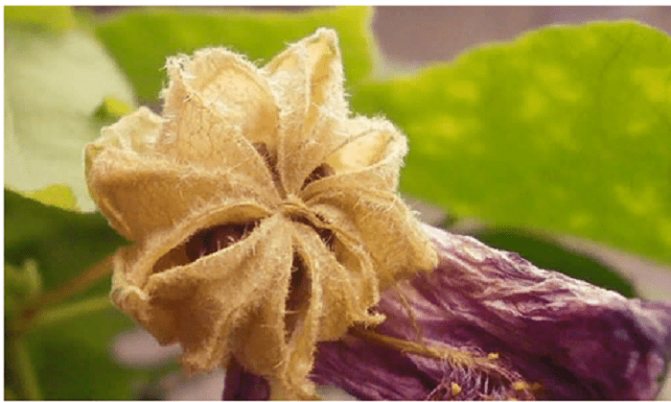

After about a month, it will open
Variegated varieties do not retain their color when propagated by seeds. At the initial stage, seeds are sown without burying them. Monitor soil moisture. You can immediately plant the seeds in peat tablets.
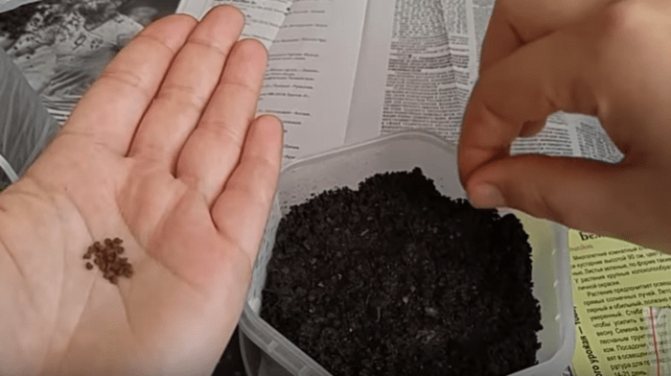

Sowing seeds in a closed container
Experienced growers have noticed that the best time for seed germination is spring. The best way to germinate is to create a greenhouse effect. For this, containers are used that are closed with glass, a lid or wrapped in cellophane film.
Good to know.The seeds are pre-soaked in water at a temperature of 15-18 ° C, and they germinate better at a temperature of 25 ° C. It is convenient to use cotton pads or napkins.
The soaking process is optional. The first shoots appear within 3 to 21 days.
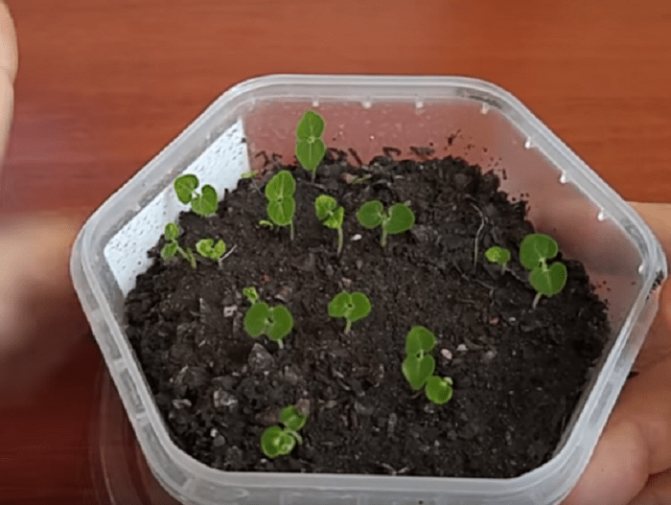

First shoots
About a month after the sprouts appear, the seedlings are seated in separate cups. 1-2 tablespoons of coarse river sand or other drainage material are poured into the bottom.
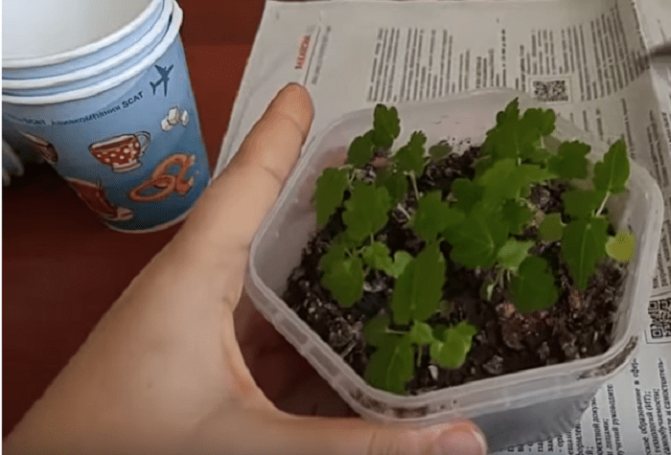

Transfer to cups
The growing plant is transplanted into a larger pot, following the rules for care, transplantation, pruning and bush formation described above.
Reproduction method by grafting
It is used when forming an abutilon tree with various varieties on one trunk.
Reproduction and cultivation of indoor maple
The plant reproduces well by cuttings. For this, cuttings are used, cut in the process of care and pruning for indoor maple. They take root equally actively, both in water and in soil.
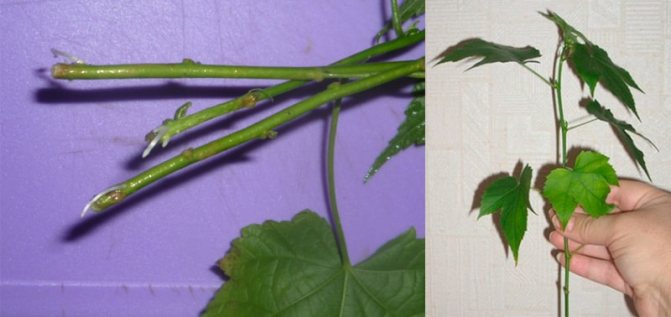

Abutilone stalk for reproduction
If the stalk is placed in a rooting substrate, be sure to cover it with plastic wrap or glass jar, occasionally removing the artificial "greenhouse" for ventilation.
Sometimes in flower shops you can find abutilon seeds on the shelves. As a rule, plants with green monochromatic leaves are grown from them. Variegated varieties are not derived from seeds.
Bush formation and pruning
Homemade maple grows quickly. It can reach 1.5-2 meters in height. Therefore, he needs pruning and shaping a bush. Otherwise, it loses its shape, the buds are located only at the edges of the shoots.
At the end of February, they begin the procedure for rejuvenating the bush. To do this, shorten the main branches by about half. In cases of strong elongation of the shoots, leave 4-5 cm from each of them.
Another situation - over the summer the bush has grown a lot. Then, in November-December, before the onset of the dormant period, excess branches are removed.
Important advice. If you want to form a plant with a bush, it is necessary to regularly pinch the shoots after the third internode. The procedure is carried out after the main axis grows up.
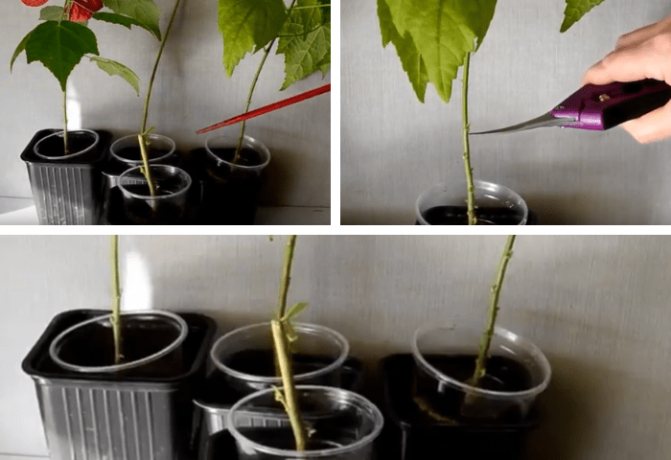

Abutilon perfectly tolerates pruning and pinching
Pruned twigs are an excellent planting material for propagation.
Those who want to get a standard tree should do the following:
- wait until the abutilone grows to the desired height; pinch the top of the head;
- then remove the branches growing from the bottom;
- install a support and attach a tree to it;
- cut off growths thickening the crown.
Small varieties (for example, abutilones from the Bella group), seedlings and cuttings with a straight stem are better suited for the formation of a standard tree.
Indoor plant pruning
Various methods of forming the crown of a plant allow you to get a specimen in the form of a lush bush or indoor tree with a rounded crown. Abutilon should be pruned twice a year in the spring and fall between flowering phases.
Domestic maple is capable of reaching a height of two meters in the absence of timely pruning.
First of all, weak shoots and branches growing inside the crown are completely removed. The remaining branches are cut in half. The tree is formed after identifying one strong stem, which is only pinched. The lower side branches are removed to a certain level. By sticking to this pruning method, it is easy to get an indoor ever-flowering tree.
A lush bush is formed by frequent pinching of the terminal buds. It is imperative to remove branches growing inside the crown. The crown, well ventilated and accessible for lighting, is an excellent means of preventing pests and diseases. Regular pruning maintains the harmonious development of abutilone, accompanied by long flowering.
Problems encountered when caring for abutilone
Frequent worries of plant owners are associated with its flowering. It takes 3-5 months after sowing the seeds, homemade maple has grown, but flowering does not occur. The main reasons for this phenomenon are:
- insufficient lighting;
- too large a pot - the abutilone has to spend a lot of effort filling it with roots.
With insufficient watering, a deficiency in dressing, the presence of drafts, it can throw off the buds that have tied up.
The second problem has to do with leaves. Let's consider the most common ones:
- Shedding or shedding of leaves is associated with the onset of a dormant period, fertilizer deficiency or root damage.
- The curling of the leaves occurs when exposed to sunlight, low humidity, high ambient temperatures.
- Lack of light or fertilizer causes the leaves to turn yellow. It is enough to move the abutilone to another place, fertilize - the problem will be solved. Inspection for the presence of pests will not hurt.
- Leaves acquire a light shade when irrigation schedule is violated, lack of trace elements, sunlight and fresh air. When watering, you need to pour out less water, but do it more often. Ventilate the room, fertilize with complex fertilizer.
Possible problems
Indoor banana (banana palm) - home care
What problems arise when growing maple at home:
- sheds leaves and buds. Reasons: drafts, improper watering, sudden temperature changes;
- leaves turn pale. The reason is the lack of lighting;
- the ends of the leaves curl and dry out due to low humidity;
- yellow leaves, spots on them. The reason is lack of nutrients;
- the lower leaves fall. Due to the high temperature of the content or low humidity;
- pests. The delicate leaves of abutilone are attacked by many pests. These include scale insects, whiteflies, spider mites, aphids, etc. Weak specimens, exhausted by improper care, are especially susceptible to attacks. Insecticides and acaricides are used to control pests.
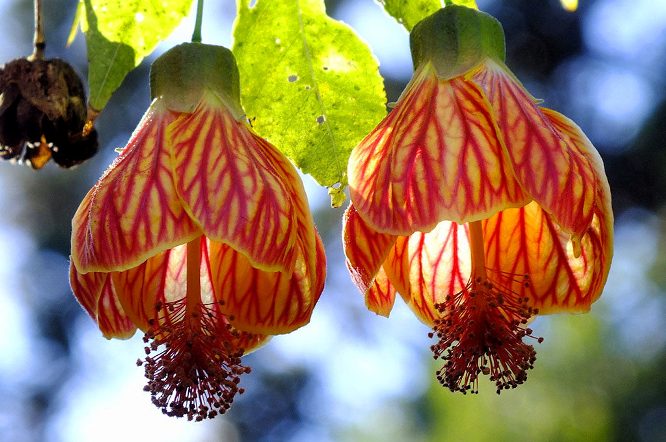

Leaf damage by scabbard
Diseases and pests dangerous for abutilone
Indoor maples are relatively disease resistant. Sometimes rust is visible on the green mass. This is a fungal disease. It is necessary to remove the affected areas and spray the bush with topaz.
This tool is also used for the prevention of fungal diseases, powdery mildew. The flower is sprayed during vegetative growth.
The appearance on the leaves of a mottled variegated pattern indicates a disease of the plant with a viral mosaic. Abutilone striped is especially susceptible to this disease during flowering.
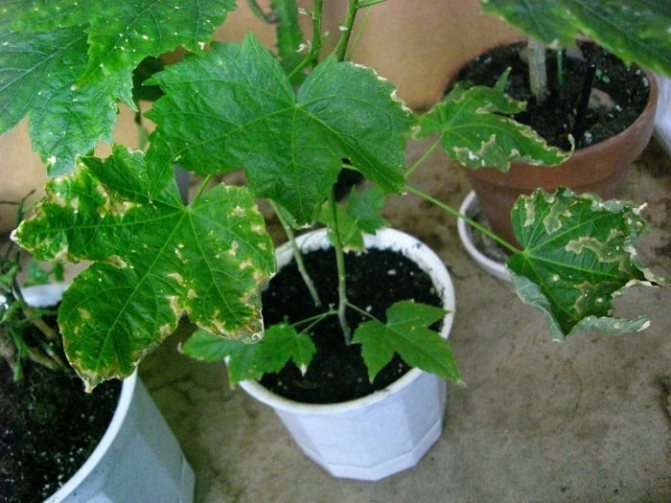

Sick Abutilone
Pests do more harm to abutilone. Spring is a dangerous time. At this time, the plant is weakened after wintering, its vulnerability increases.
The scale insect, aphid, spider mite, whitefly are its most frequent enemies.
Signs of colonization of the scale insect: Abutilone coating with sticky spots, and then the appearance of small brown plaques. They are removed with a cotton pad dipped in soapy water, and then the plant is treated with chemicals (for example, Aktara).
Aphids do double harm - they weaken the plant by sucking sap, and are a source of viral diseases. In addition to processing with agrovertine, a folk remedy is used - an infusion of garlic or a solution with the addition of laundry soap.
The appearance of gray or black dots on the lower part of the leaves, cobwebs warn us about the presence of a spider mite. Several treatments with agrovertine or phytoverm help. Frequency once every 7 days.
As a prophylaxis and treatment, spraying with prepared solutions with the addition of tobacco, boric acid can be carried out.
Whitefly is called one of the main enemies of abutilon. Florists advise to periodically alternate spraying it with garlic infusion and a solution with the addition of laundry soap.Once a month, treat the plants with Aktara (work on the street).
The most common types of abutilon plant:
Abutilon Sello
A hybrid variety of domestic maple, belongs to the varieties with striped leaves. The plant is weakly branched with straight, slightly pubescent shoots. The sheets have three elongated, pointed lobes.
Forms light purple inflorescences with pink streaks. Blooms from mid-summer to early winter. In favorable conditions, it grows up to two meters.
Abutilon hybrid
This species belongs to American hybrids and has a large number of varieties. Distributed in the form of an evergreen bush with brown bark. The photo shows that the leaves can be either three-lobed or five-lobed.
Flowers, like leaves, are covered with light fluff and are bell-shaped. They are located on petioles up to twelve centimeters long. The color can be white, red, golden or burgundy. The height of the tree itself reaches one and a half meters.
Abutilon Darwin
Abutilon Darwin is quite beautiful, but rarely found in indoor floriculture. Large, three-lobed leaves with long petioles are located on fluffy, silky shoots that reach one meter in length. The bottom sheets can have up to seven lobes, while the one in the middle is strongly elongated.
The bells of the inflorescences (five centimeters in diameter) are bright orange in color and red veins. Blossom in groups of up to three pieces from one bosom. Flowering lasts from early April to late September.
Abutilon Juliet
A very unpretentious variety of homemade maple. Growing fast enough, the growth is up to fifty centimeters per year. Florists appreciate it for the fact that it is not picky about lighting and blooms throughout the year. The flowers are large, about six centimeters in diameter. Flowering begins as early as the fifth month after sowing the seeds.
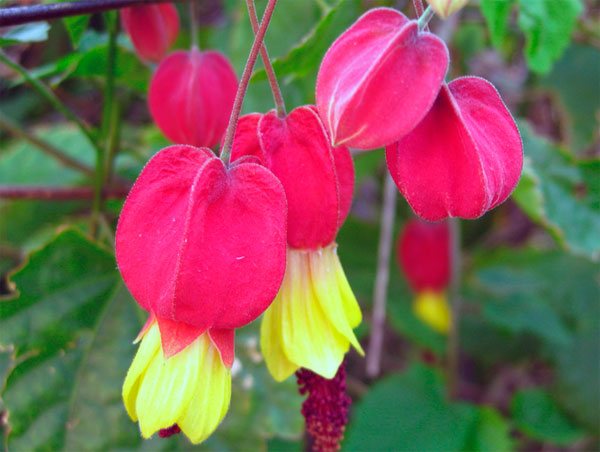

Abutilon megapotamskiy
Abutilon Megapotamian is often called the Amazonian, Brazilian, or simply the weeping Chinese lantern. As a rule, it grows no higher than one and a half meters. A characteristic feature of this species is drooping shoots.
The bright green leaves have an elongated oval shape with jagged teeth and reach eight centimeters in length. Peduncles are arranged singly on long petioles hanging down.
The flowers have pale yellow petals with a red spot at the base and a bright red corolla. Under favorable growing conditions, it can bloom constantly.
Abutilon spotted
Spotted abutilon is also called painted. It grows as a small shrub with short, soft shoots that never become woody.
The leaves are heart-shaped and have long petioles. They can contain from three to six blades. They are smooth without characteristic pubescence, rich green color with white spots, which are located closer to the edges.
The flowers are bell-shaped, unusual, with a very long red-golden corolla. Flowering lasts only a few months, most often in August and September.
A very beautiful variety of abutilon spotted is thompsonii Vetch... It grows up to two meters in height. Large (up to ten centimeters long) leaves are not pubescent, have a dark green color with bright yellow spots. Peduncles are large enough (about seven centimeters in diameter), can have a simple or double shape and are red or yellow. It blooms a little, only the month of June.
Abutilon Bella
This variety is very decorative and compact. It is very branched and even. A characteristic feature is the formation of a large number of bright, large flowers, which look very impressive against the background of rich green foliage. Bella is very similar to the Isabella species of abutilone, differing in even larger flowers.
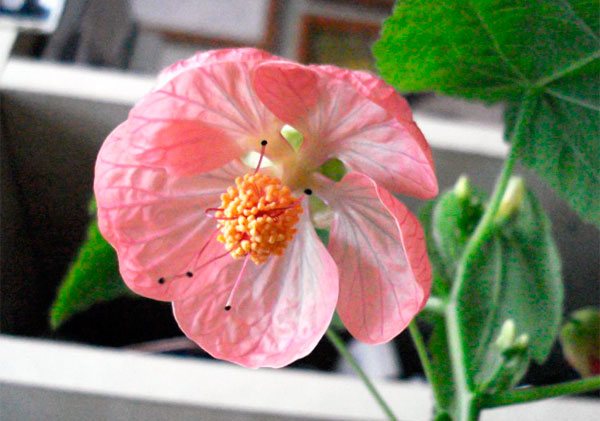

Abutilon Bellevue
Bellevue translates as a beautiful view of something. Indeed, with proper care and timely pruning, this hybrid mixture forms, as seen in the photo, very beautiful, lush bushes up to two meters long. The flowers have a hanging bell shape and a variety of colors: red, yellow, orange and pink.
Abutilon grape-leaved
It grows in the form of a large shrub up to two or more meters high with easily pubescent shoots and green, velvety leaves. They are divided into three or five lobes, and have a well-pronounced scalloped edge and are up to fifteen centimeters long. Peduncles are collected in a cluster of several pieces and are located on very long petioles. The color is usually lilac or blue, often with darker streaks. Blooms in May.
Abutilon Indian
It is a charming annual herb. It has very small bell flowers and beautiful thick, velvety leaves. Peduncles are usually light cream on the outside and dark on the inside.
There are also ampelous types of home maple.

